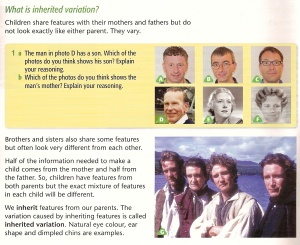It’s official – I’m a textbook genetic freak!
 Today my 14 year old son returned home with his science coursework book. He’d been studying the subject of genetic inheritance. He had that particular smirk on his face usually reserved for my personal humiliation.
Today my 14 year old son returned home with his science coursework book. He’d been studying the subject of genetic inheritance. He had that particular smirk on his face usually reserved for my personal humiliation.
“Did you know that you were part of my science syllabus, Dad”? he asked.
I didn’t. I was intrigued. He opened his book at page 53. And there I was. Clear as day. He was absolutely right. My photograph stared out of his science textbook! I am part of the science curriculum! All those childhood dreams of playing my part in the education of future scientists had come to pass! Newton, Einstein, McGann. How easily those names trip off the tongue…
Yeah. In my dreams…
The photograph is actually one of me with my three siblings. It was taken from an old UK television serial we’d made together in the nineties. It is included in this textbook as an extreme example of genetic inheritance amongst family members. In short, we all look very alike. This is the polite UK schoolbook version of a Victorian freak show – “Roll up, Roll up! Come and see the freakishly identical thespians!”. Now okay, I’ll admit it. We do look kind of similar in a certain light. Not as much as you’d think. Honestly. Not in real life. When we’re all together, you’d be surprised at the difference…really…
Anyway, there I am. My son – predictably – finds it hilarious. And to be honest, I rather like it too.
A few weeks ago, I attended a seminar given by the wonderful Andrew Hunt. Andrew’s career has spanned 20 years of British science education, and he has made an invaluable contribution to the teaching of science in UK schools. To hear Andrew talk is to hear British education history played out in personal experience. Some of it has been fairly ugly. I am old enough to have been a guinea pig for some of the education experiments of the sixties and seventies. Yet Andrew has worked tirelessly to promote a more enlightened curriculum for science that includes essential insights into science practice, as well as science facts.
It is a common criticism in science communication that the ‘public’ don’t understand what it is that scientists do. They don’t know about the methods used to derive the knowledge that science produces. This is a real problem – because if citizens can’t understand the complexity and uncertainty inherent in science practice, then they may hold false hopes and expectations about what scientists can do for them. Yet for years, nobody had made any effort to tell the public what science did. Andrew felt very strongly that British science education should include this methodological element, as well as all the standard facts and equations.
The latest textbooks include just that. A week after listening to Andrew, I was helping my son with his Physics revision. As I flicked through his textbook, testing him on the course material, I was delighted to find a section outlining the scientific method – together with case studies and accounts of real scientists in the field discussing their day-to-day work. I think this is a real improvement from my day. I looked at the front of the book to check the names of contributors. Andrew Hunt’s name was amongst them.
So my inclusion in my son’s book is really just a part of making science an everyday phenomenon. Bringing to life what the science shows, and what it does. Making it belong to everybody. And that – to me – is a very good thing. So I’m glad to play my small and freakish part in that process 😉
Mind you, this is DEFINITELY going on my CV: “Has made unique contribution to British science curriculum in the field of genetics.”
Just don’t tell the other freaks….
Reference
Johnson, P. & Grey, S. (2008). Exploring science : how science works., Harlow Essex: Pearson Longman. ISBN: 9781405892469

Yes, we had that text book with you all in it, you are the least like the others. That is my scientific contribution and oh yes the text books do seem more interesting, but I suppose Science for the Seventies was cutting edge in its day!
Haha, your name will go down alongside the Peppered Moths!